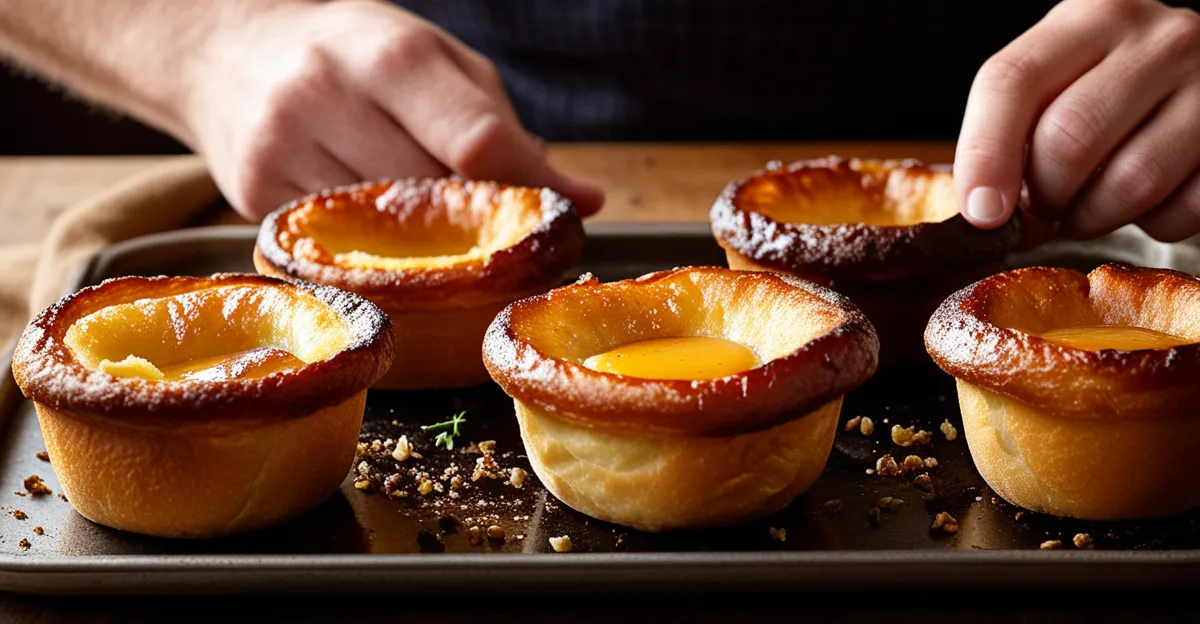Essential Tips for Perfect Yorkshire Pudding
Achieving the perfect Yorkshire pudding hinges on mastering ingredient ratios, batter handling, and oven conditions. The ideal rise and texture depend heavily on balancing the amount of flour, eggs, and liquid. A classic expert Yorkshire pudding advice emphasizes a thick, smooth batter with roughly equal parts flour and liquid by volume, combined with enough eggs to provide structure and lift. This balance ensures a batter that’s neither too thin nor too dense, helping it puff up beautifully during baking.
Another vital tip is allowing the batter to rest before baking. Resting the mixture for at least 30 minutes lets the flour absorb the liquid fully and results in a more elastic batter, which in turn creates better rise and texture. Mixing technique also plays a crucial role—use a whisk or fork to combine ingredients gently, avoiding overmixing which can develop gluten and make the puddings tough.
Also to see : What are the techniques for achieving a crispy fish and chips?
Finally, the oven temperature and pan heat must be spot on. Preheat the oven to a high temperature (around 220°C/425°F) and make sure the fat in the tin is smoking hot before pouring the batter. This immediate sizzle on contact helps the batter rise rapidly, forming the characteristic crispy edges and airy center. Consistency in these variables is essential to mastering the art of perfect Yorkshire pudding every time.
Choosing Ingredients and Tools for Success
Selecting the right Yorkshire pudding ingredients is foundational to baking success. Plain wheat flour with a medium protein content is ideal, as it provides enough gluten for structure without making the puddings tough. Eggs should be fresh and at room temperature to help bind the batter and contribute to its rise.
Also read : What are the essential tips for baking a rich and moist Victoria sponge cake?
Choosing the best fat for Yorkshire pudding is equally important. Traditional recipes often use beef dripping, prized for its high smoke point and ability to create crispy edges. However, vegetable oils with neutral flavor and high heat tolerance can also produce excellent results. Butter, while flavorful, tends to burn at the high temperatures needed, so it is less recommended unless combined with another fat.
Regarding baking tools, using sturdy, heat-conductive tins is crucial. Metal muffin tins or dedicated Yorkshire pudding pans with individual wells allow even heat distribution, supporting the rise and crisping process. Avoid silicone or glass pans, as they typically don’t reach the temperatures necessary to create the signature puffed texture. Additionally, a reliable oven thermometer can ensure the oven stays at the required high temperature, a key factor in making perfect Yorkshire pudding.
Common Yorkshire Pudding Mistakes to Avoid
Avoiding common Yorkshire pudding mistakes is crucial to consistently baking perfect Yorkshire puddings. One frequent error is improper filling of the tin—either overfilling or underfilling can drastically affect how the batter rises. Overfilled tins prevent the batter from expanding properly, leading to dense, flat puddings. Conversely, underfilling results in puddings that are too small and may cook too quickly, losing the desired texture.
Another critical mistake involves not heating the fat and oven to the right temperature. If the fat isn’t smoking hot before batter insertion, the batter won’t sizzle on contact, which is essential for rapid rise and crispy edges. Similarly, an oven not reaching approximately 220°C (425°F) won’t provide the intense heat needed for proper puffing. This ties directly to the second key question: why do Yorkshire puddings fail? Often, failure to achieve the correct temperature is the primary reason.
Opening the oven door during baking is yet another common oversight. This disturbs the hot air and causes temperature fluctuations, leading the puddings to collapse mid-cook. Maintaining a steady oven environment, without interruptions, is essential for the batter to set and rise perfectly. Understanding these Yorkshire pudding troubleshooting tips empowers bakers to diagnose and fix problems efficiently, avoiding repeated failures.
Step-by-Step Yorkshire Pudding Preparation Guide
Mastering how to make Yorkshire pudding requires attention to each stage of the process. Start with the batter, which combines flour, eggs, and milk into a smooth mixture. When mixing, use a gentle folding motion rather than vigorous stirring. This technique incorporates air without overdeveloping gluten, which prevents toughness. Aim for a consistency that coats the back of a spoon—neither too runny nor too stiff.
After mixing, allow the batter to rest for at least 30 minutes. This pause is essential as it enables the flour to fully hydrate, resulting in a batter that is more elastic. Resting helps develop the structure needed for an impressive rise during baking and improves the texture by making the puddings lighter and airier.
When ready to bake, ensure the fat in your preheated tin is smoking hot. Pour the rested batter quickly into the hot fat to trigger immediate rising. Pouring swiftly helps create the characteristic puff and crisp edges, locking in the steam that forces the batter upwards. Bake in a preheated oven at around 220°C (425°F), avoiding opening the door to ensure consistent heat. Follow these instructions carefully to achieve a perfectly risen, crispy Yorkshire pudding every time.











